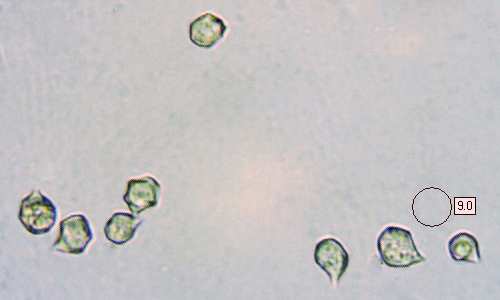Entoloma sinuatum (Pers.) P. Kumm. - Livid Pinkgill
Phylum: Basidiomycota - Class: Agaricomycetes - Order: Agaricales - Family: Entolomataceae
Distribution - Taxonomic History - Etymology - Toxicity - Identification - Reference Sources
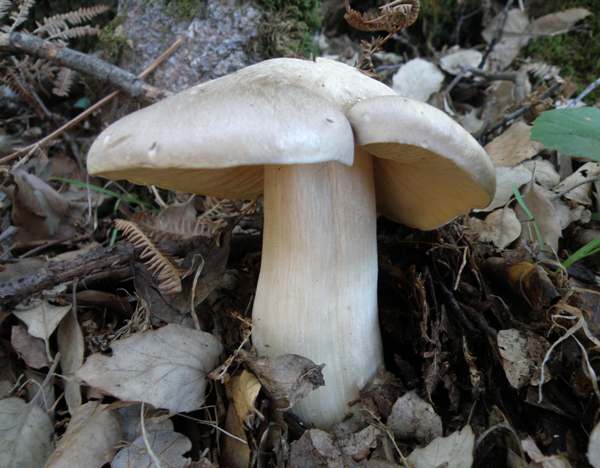
Entoloma sinuatum (frequently-used synonym Entoloma lividum), known as the Livid Pinkgill, is a large and very poisonous species. Perhaps fortunately, it is not particularly common in Britain and Ireland; however, its pallid appearance means that inexperienced mushroom collectors can confuse it with edible Agaricus mushroom or for Clitopilus prunulus, the Miller, which is generally considered edible, or perhaps even mistake it for a late-fruiting (and highly-prized edible) St George's Mushroom, Calocybe gambosa.
Distribution
Although widespread, the Livid Pinkgill is an infrequent find in Britain and Ireland; it occurs throughout mainland Europe and in many parts of North America.
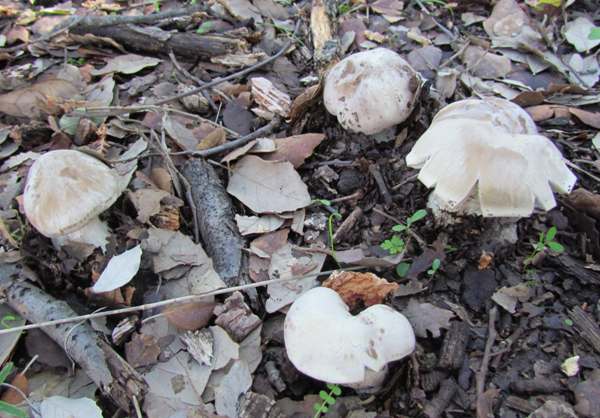
Taxonomic History
This species was described scientifically by Jean Baptiste Francois (Pierre) Bulliard in 1788, when he named it Agaricus lividus. (Most gilled fungi were initially placed in a giant Agaricus genus, now redistributed to many other genera.) However, the first valid name (under the current ICBN rules) is now Agaricus sinuatus, given to it when Christiaan Hendrik Persoon described this species in 1801. In 1871 the famous German mycologist Paul Kummer transferred this species to its present genus, renaming it Entoloma sinuatum.
Synonyms of Entoloma sinuatum include Agaricus sinuatus Pers., Entoloma lividum (Bull.) Quel., Rhodophyllus lividus (Bull.) Quel., and Rhodophyllus sinuatus (Bull.) Quel.
Entoloma sinuatum is the type species of the Entoloma genus.
As shown above, the Livid Pinkgill Entoloma sinuatum usually occurs in small scattered groups rather than as singletons.
Etymology
The generic name Entoloma comes from ancient Greek words entos, meaning inner, and lóma, meaning a fringe or a hem. It is a reference to the inrolled margins of many of the mushrooms in this genus.
More obviously, the specific epithet sinuatum is a reference to the sinuous or wavy nature of mature caps (and the gills are sinuate too!), while the former specific name lividum means leaden (lead coloured) - not inappropriate for a toxic toadstool that was once most commonly referred to in Britain as the Lead Poisoner.
Toxicity
The toxins in Entoloma sinuatum that cause severe stomach pains, sickness and diarrhea have not been isolated, but the effects can be long lasting and at least one fatality has been attributed to eating these mushrooms. Because they look quite similar to some popular edible species, a high proportion of fungus poisoning cases in Europe are attributed to eating this mushroom species by mistake.
Identification guide
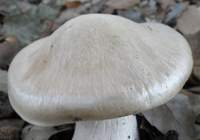 |
CapIvory white, darkening with age; conical then convex to plane with a blunt umbo; slightly sticky when young; margin sometimes lobed. Entoloma sinuatum is the largest of the Entoloma species, with caps ranging from 6 to 15cm across when fully expanded. In very hot weather the cap edge tends to split as the down-turned margin flattens. |
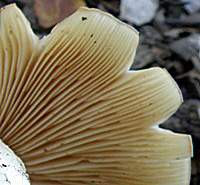 |
GillsYellowish white initially, the sinuate, crowded gills of Entoloma sinuatum turn more pinkish as the spores mature. StemIvory white; smooth; cylindrical but sometimes bulbous at the base; 3 to 10cm long, 0.6 to 1.5cm diameter; no stemring. |
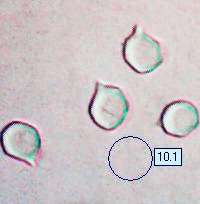 |
SporesSubglobose, angular, 7-10 x 7-9µm, with an extremely prominent germ pore.
Spore printPink. |
Odour/taste |
Odour vague but rather unpleasant; taste not distinctive. |
Habitat & Ecological role |
Probably mainly saprobic, in broadleaf woodland. This deadly poisonous pinkgill, which is also known as the Lead Poisoner despite (not always having a leaden appearance) is reported to be able to form mycorrhizae with willows. |
Season |
Fruiting from early summer to late autumn in Britain and Ireland but continuing into the New Year in Mediterranean countries. |
Similar species |
This pale-capped mushroom could be confused with St George's Mushroom, Calocybe gambosa, which usually fruits from Springtime until early summer, has white gills and a distinctly mealy odour. Many other white or pale-capped fungi occur in similar habitats - Clitocybe nebularis, is one such example - but gill colour and odour help differentiate them from pale Entoloma species. |
Reference Sources
Fascinated by Fungi, 2nd Edition, Pat O'Reilly 2016, reprinted by Coch-y-bonddu Books in 2022.
Knudsen H., Vesterholt J. (eds) Funga Nordica: agaricoid, boletoid and cyphelloid genera - Nordsvamp, 2008
Dictionary of the Fungi; Paul M. Kirk, Paul F. Cannon, David W. Minter and J. A. Stalpers; CABI, 2008
Taxonomic history and synonym information on these pages is drawn from many sources but in particular from the British Mycological Society's GB Checklist of Fungi.
Fascinated by Fungi. Back by popular demand, Pat O'Reilly's best-selling 450-page hardback book is available now. The latest second edition was republished with a sparkling new cover design in September 2022 by Coch-y-Bonddu Books. Full details and copies are available from the publisher's online bookshop...

